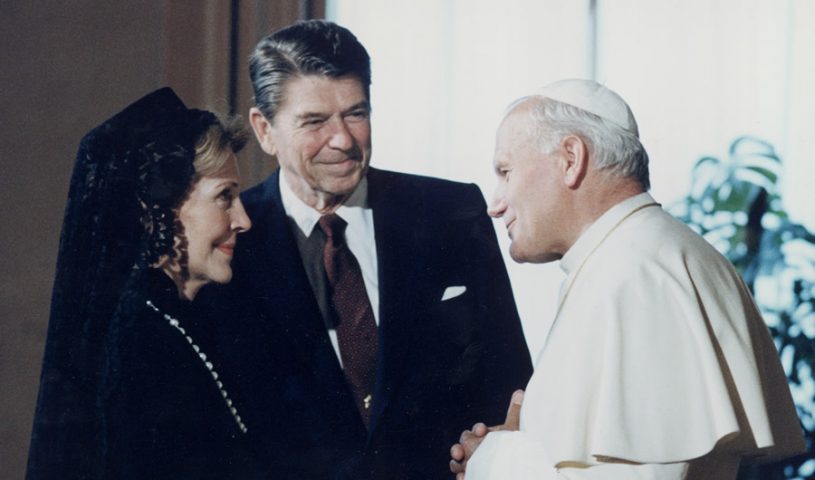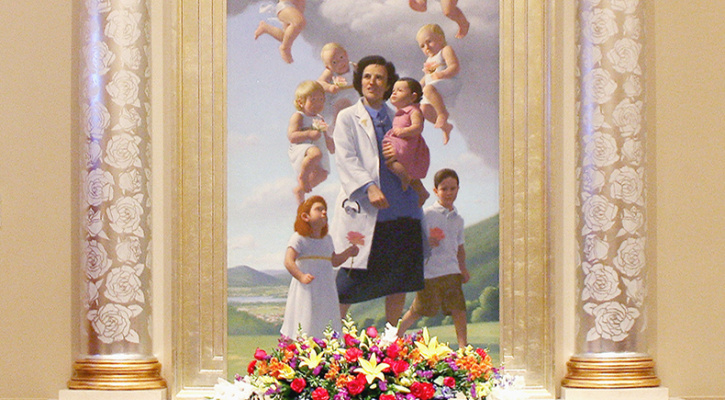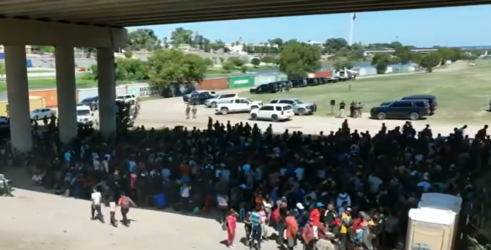35 Years Ago: When Ronald Reagan and Pope John Paul II Met to Defeat an Evil Empire

OPINION: The Liberal Jesuit Captivity of the Papacy
July 6, 2017
Pro-Life Group Delivers Baby Hope to 100 US Senators Demanding the Defunding of Planned Parenthood
July 6, 2017
 The following article is the fifth in a six-part series of excerpts adapted from Paul Kengor’s new book, A Pope and a President: John Paul II, Ronald Reagan, and the Extraordinary Untold Story of the 20th Century. The book is based on nearly two decades of archival research. This series will feature five articles focused on five eras covered in the book. This excerpt comes from chapter 21, “June 1982: Face to Face in the Vatican.”
The following article is the fifth in a six-part series of excerpts adapted from Paul Kengor’s new book, A Pope and a President: John Paul II, Ronald Reagan, and the Extraordinary Untold Story of the 20th Century. The book is based on nearly two decades of archival research. This series will feature five articles focused on five eras covered in the book. This excerpt comes from chapter 21, “June 1982: Face to Face in the Vatican.”
Mr. Reagan Goes to Rome
Late in the morning on June 7, 1982, two kindred spirits finally met. Pope John Paul II and President Ronald Reagan convened at the Vatican. For Reagan, this visit fulfilled his long wish to reach out to the pope and the Vatican and “make them an ally.”
A year of communications had been building to this moment. John Paul II acknowledged that. He greeted Reagan before the press. “Mr. President,” he said, “I am particularly pleased to welcome you today to the Vatican. Although we have already had many contacts, it is the first time that we have met personally.”
The pope and the president retired to the Vatican Library. For 50 minutes they talked there, just the two of them. There were no translators, no aides. Right away, they raised a painful subject. Each of them was shot the year before. They agreed that a hand from heaven spared them. “Look how the evil forces were put in our way and how Providence intervened.” So Reagan said to the pope, according to Archbishop Laghi. John Paul II agreed.
Bill Clark said the two discussed the “miraculous” fact that they had survived. Ironically, the assassination attempts that could have kept them from ever collaborating actually (as Clark put it) “brought them closer together.”
Clark said that the two men “discussed the unity of their spiritual views.” They huddled at the Vatican “to pray together and talk about life.” Yes, the pope and the Protestant president prayed together.
Because of his window into Reagan’s soul, Clark was probably best equipped to analyze the spiritual aspect of the president’s relationship with John Paul II. “Both are deeply prayerful — in Reagan’s case, without public display,” Clark said. The spiritual bond came to the fore in this first face-to-face meeting. Sitting in the Vatican Library that day, each leader shared a conviction: They had been given “a spiritual mission — a special role in the divine plan of life.” Both men, said Clark, considered the assassination attempts to be “wake-up calls… driving them onward even more forcefully.”
Their conversation quickly turned to “their concern [for] the terrible oppression of atheistic communism.” According to Clark, the two men shared a “vision on the Soviet empire.” They believed “that right … would ultimately prevail in the divine plan.” Both agreed that “atheistic communism lived a lie that, when fully understood, must ultimately fail.” They saw that each played a role in what Clark called “the war of good against evil.” Each was inspired by the other’s “increasing courage and action” in that war.
Both leaders were convinced that a free Poland would be, in Bernstein’s words, “a dagger to the heart of the Soviet empire.”
More than 25 years later, Clark remembered June 7, 1982, as a “wonderful day.” A transformative one. That day “gave the president and pope the ability to form a very personal relationship.”
Just as important, the meeting led to real action. Ronald Reagan and John Paul II translated their lofty divine mission into a practical policy mission. They agreed to sustain the Solidarity movement in Poland. It was a potential wedge that could split the USSR’s empire. As Clark put it, “Each was successful in translating a personal vision into an underlying policy, and implementing the strategy to defeat Soviet aggression and oppression.”
Carl Bernstein corroborates these details. In 1992, Bernstein wrote a cover story for Time magazine headlined “The Holy Alliance.”
He reported that Reagan and the pope then and there, that June 7, quietly joined forces to shore up Solidarity and pressure Warsaw. Their goal? “[T]o free all of Eastern Europe.” In that first meeting, wrote Bernstein, they consented to undertake a clandestine campaign. It was meant “to hasten the dissolution of the communist empire.” The two men “were convinced that Poland could be broken out of the Soviet orbit if the Vatican and the U.S. committed the resources to destabilizing the Polish government and keeping the outlawed Solidarity movement alive after the declaration of martial law in 1981.” Reagan told the pope: “Hope remains in Poland. We, working together, can keep it alive.”
Both leaders were convinced that a free Poland would be, in Bernstein’s words, “a dagger to the heart of the Soviet empire.” They were certain that if Poland became democratic, other Eastern European states would follow.
Looking back on that 1982 meeting a decade later, one of John Paul II’s closest aides said:
Nobody believed the collapse of communism would happen this fast or on this timetable. But in their first meeting, the Holy Father and the president committed themselves and the institutions of the Church and America to such a goal. And from that day, the focus was to bring it about in Poland.
The leaders gave some hint of their new connection. It emerged in the remarks they shared with the press right after their meeting. Typically such remarks are pro forma, filled with safe diplomatic speak. The comments of the president and the pope went beyond the usual platitudes. They bespoke a true meeting of minds.
In his remarks, Reagan acknowledged the “values of freedom” which he and the pope shared. He said he was leaving their meeting “with a renewed sense of hope and dedication.” He said. “One cannot meet a man like Your Holiness without feeling that a world that can produce such courage and vision out of adversity and oppression is capable, with God’s help, of building a better future.” Reagan also referred to “certain common experiences” that he and the pope “shared in our different walks of life.” He noted “the warm correspondence we’ve carried on.” These, said the president, “gave our meeting a special meaning for me.”
The president emphasized that policy alone would not determine the outcome. He highlighted the spiritual component.
Reagan spoke of John Paul II’s pontificate and the Holy See generally as “one of the world’s greatest moral and spiritual forces” in a “troubled world … still stalked by the forces of evil.” Here, Reagan pointed to “another special area of mutual concern.” Reagan pointed to “the martyred nation of Poland — your own homeland,” which the president called “a brave bastion of faith and freedom in the hearts of her courageous people, if not in those who rule her.” He added, “We seek a process of reconciliation and reform that will lead to a new dawn of hope for the people of Poland, and we’ll continue to call for an end to martial law, for the freeing of all political prisoners.” Reagan asserted that the Solidarity movement “speaks for the vast majority of Poles.”
The Protestant president concluded by quoting the great Dante: “The infinite goodness has such wide arms that it takes whatever turns to it.”
With that, Reagan said: “We ask your prayers, Holy Father, that God will guide us in our efforts for peace on this journey and in the years ahead and that the wide arms of faith and forgiveness can someday embrace a world at peace, with justice and compassion for all mankind.”
The pope then spoke. He said:
Throughout the course of their history, and especially in difficult times, the American people have repeatedly risen to challenges presented to them. … At this present moment in the history of the world, the United States is called, above all, to fulfill its mission in the service of world peace.
He added:
America is in a splendid position to help all humanity enjoy what she herself is intent on possessing. With faith in God and belief in universal human solidarity may America step forward in this crucial moment in history to consolidate her rightful place at the service of world peace.
The special relationship cemented on June 7, 1982, would have far-reaching consequences, some of which Reagan would forecast to the world right away.
The Westminster Address
Ronald Reagan had been building up to his audience with the pope in his speeches during the weeks before. He left the Vatican prepared to engage the powers of darkness more directly than ever. The very next day, he traveled to London. There he gave arguably the most prophetic anticommunist speech of his presidency.
Addressing the British Parliament, Reagan said:
In an ironic sense Karl Marx was right. We are witnessing today a great revolutionary crisis, a crisis where the demands of the economic order are conflicting directly with those of the political order. But the crisis is happening not in the free, non-Marxist West, but in the home of Marxist-Leninism, the Soviet Union. It is the Soviet Union that runs against the tide of history by denying human freedom and human dignity to its citizens.
Reagan signaled a dramatic change when he said:
What I am describing now is a plan and a hope for the long term — the march of freedom and democracy which will leave Marxism-Leninism on the ash-heap of history as it has left other tyrannies which stifle the freedom and muzzle the self-expression of the people.
The president emphasized that policy alone would not determine the outcome. He highlighted the spiritual component. That was a topic on which he spoke with even greater confidence after his meeting at the Vatican. “For the ultimate determinant in the struggle now going on for the world,” Reagan said, “will not be bombs and rockets, but a test of wills and ideas — a trial of spiritual resolve, the values we hold, the beliefs we cherish, the ideals to which we are dedicated. … Let us now begin a major effort to secure the best — a crusade for freedom.”
Reagan expressed a belief that a people “worthy of freedom” should help others gain freedom. They should be willing to embark on a “major effort,” on a “crusade for freedom,” to help “all people” secure their “own destiny” of freedom. This was an exhortation.
John Paul II would not shirk the responsibility.
With the help of the pope, Ronald Reagan was going to try to make the crusade for freedom happen. Poland would be central to that effort.
With his speech to Parliament, his so-called Westminster Address, Reagan had laid out the goal for all the world to see: Marxism-Leninism would be tossed on the ash-heap of history.
And he had a powerful ally in the Vatican to help make it happen.
Dr. Paul Kengor is professor of political science and executive director of The Center for Vision & Values at Grove City College. His latest book is 11 Principles of a Reagan Conservative. His other books include The Communist: Frank Marshall Davis, and The Untold Story of Barack Obama’s Mentor and Dupes: How America’s Adversaries Have Manipulated Progressives for a Century.




